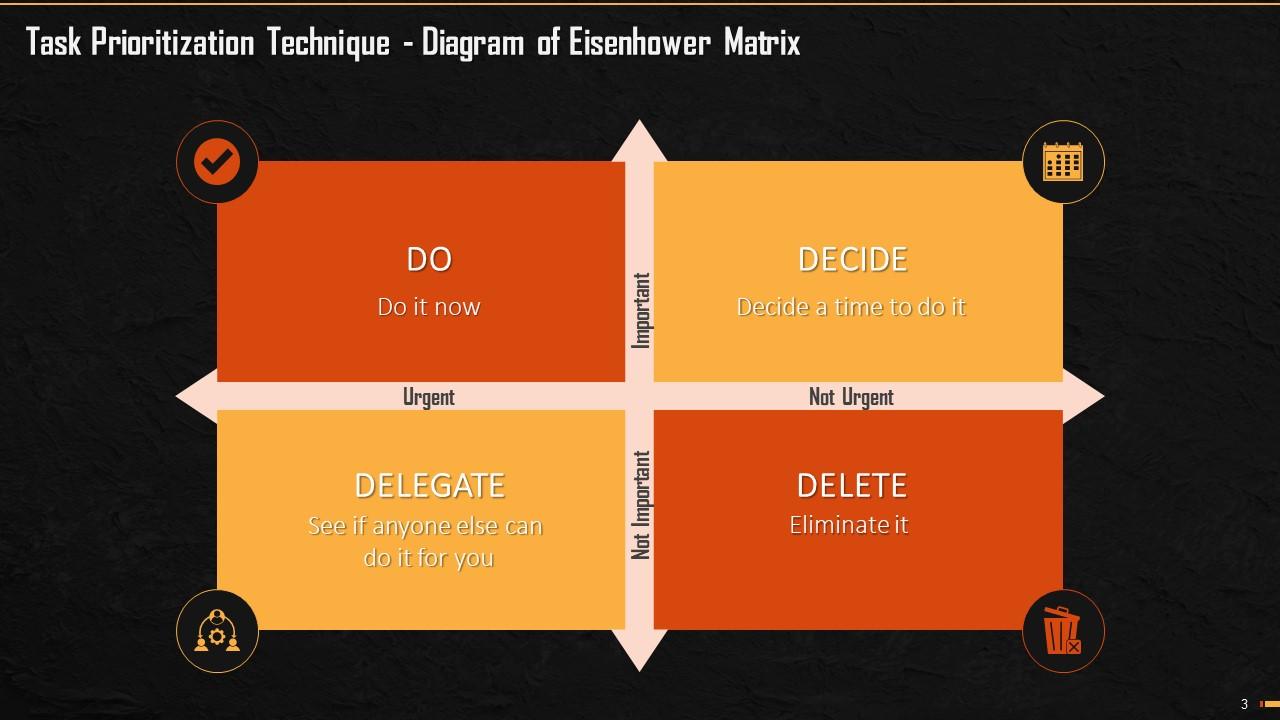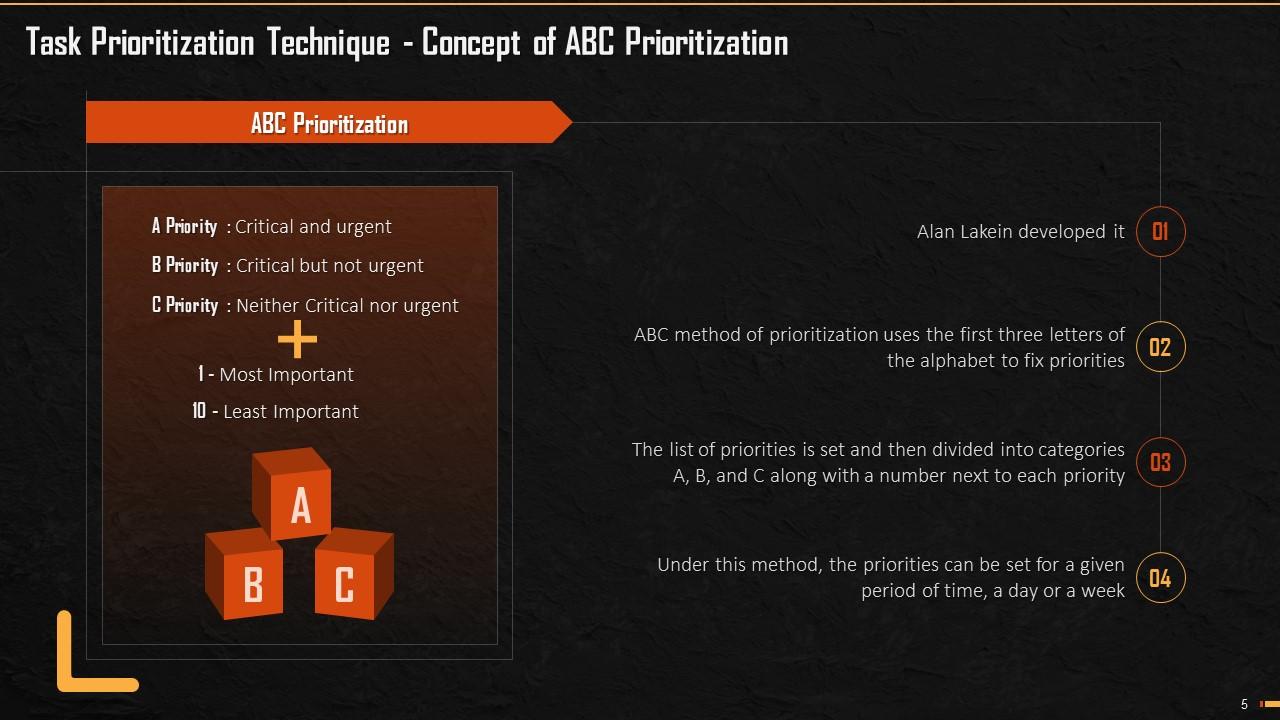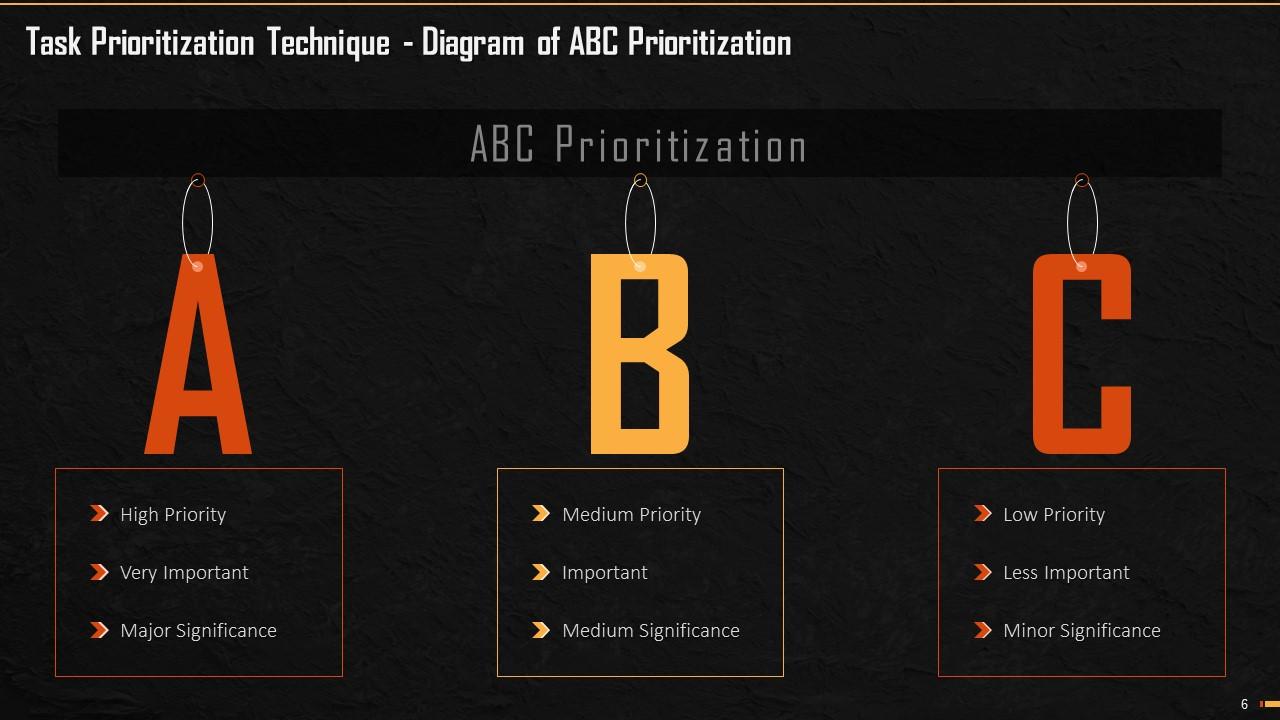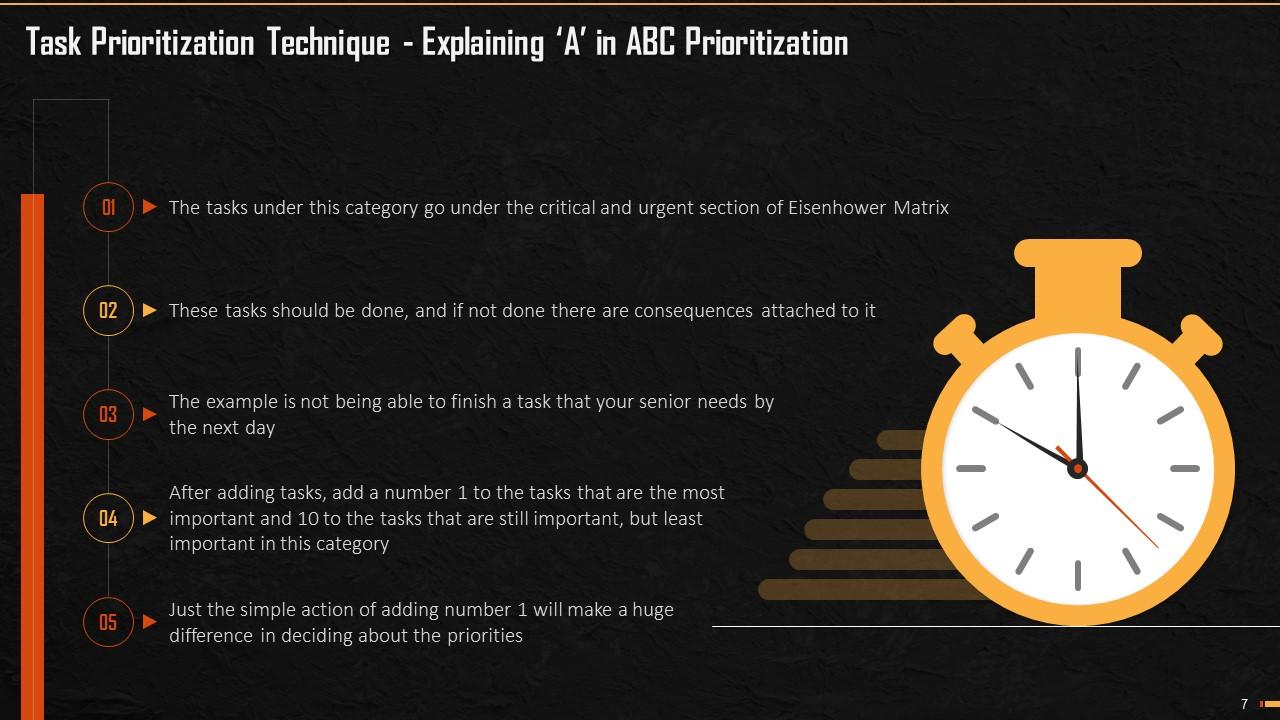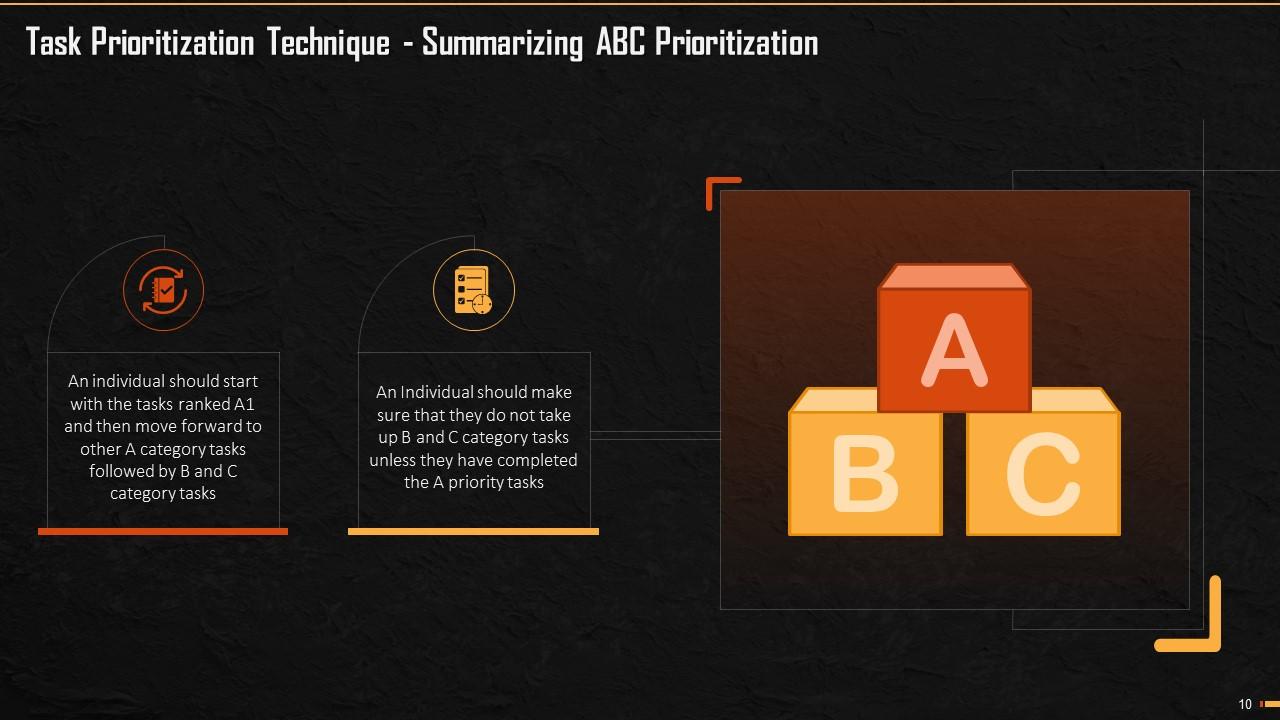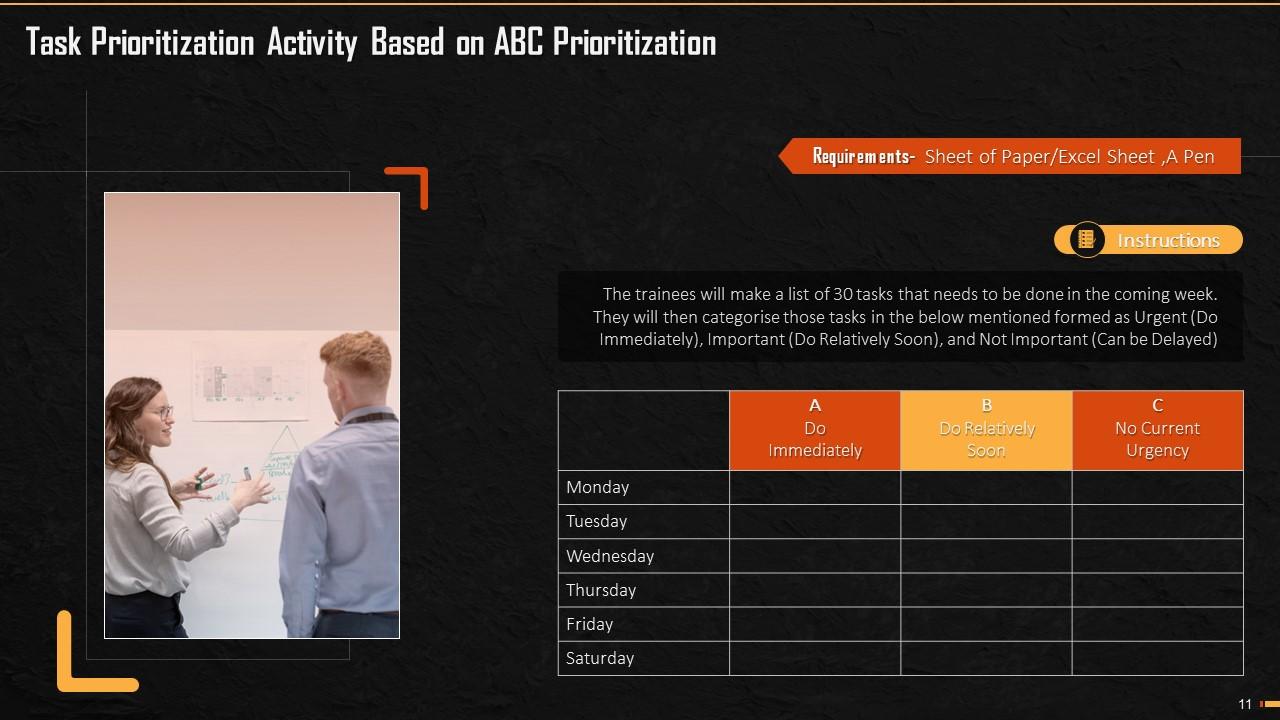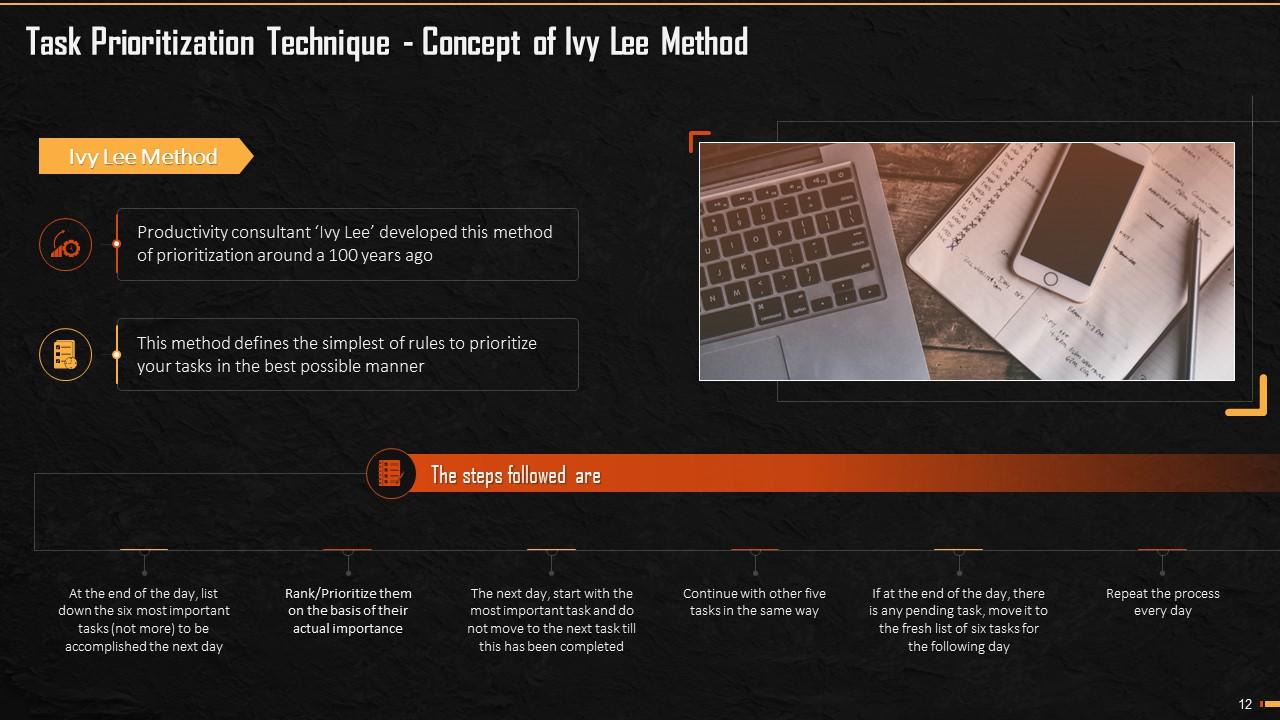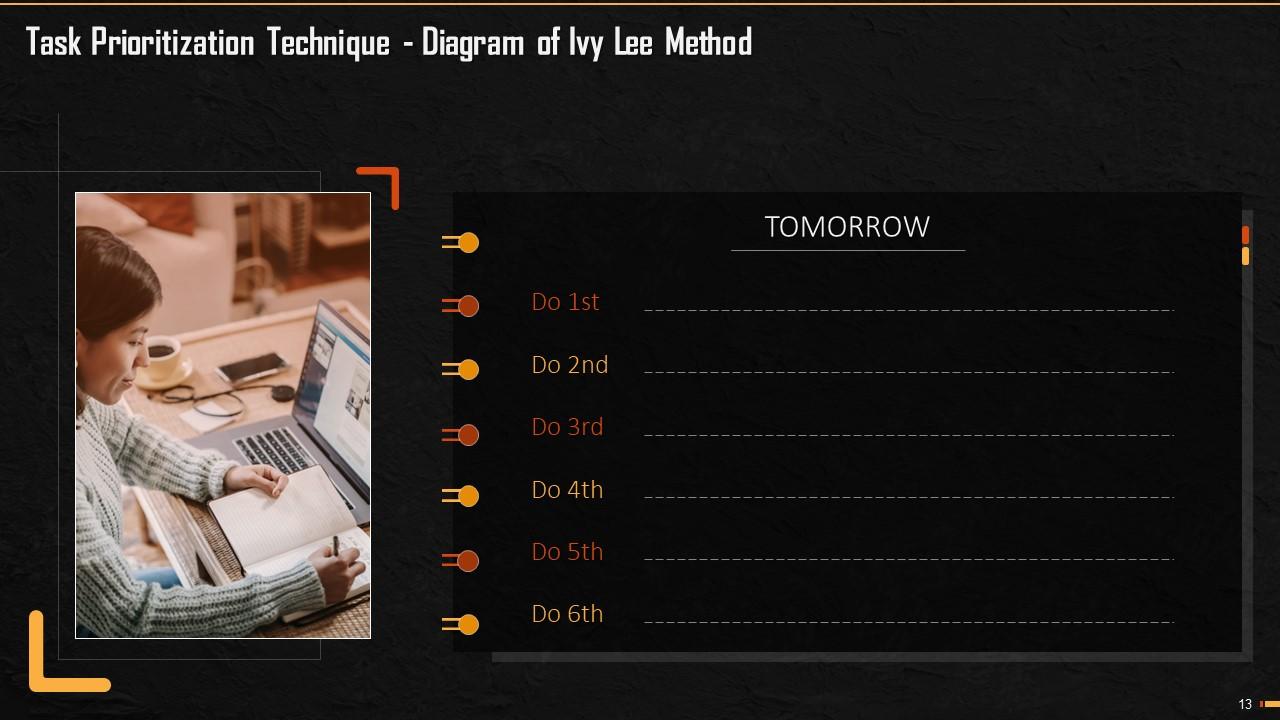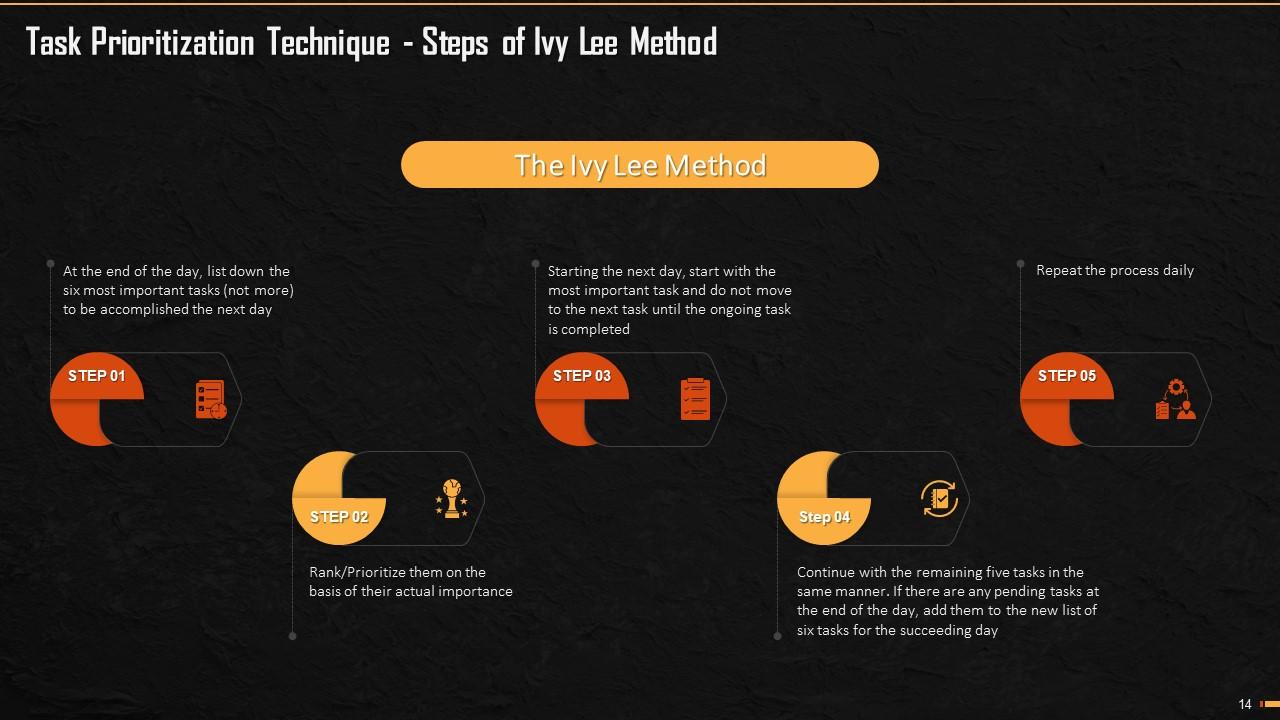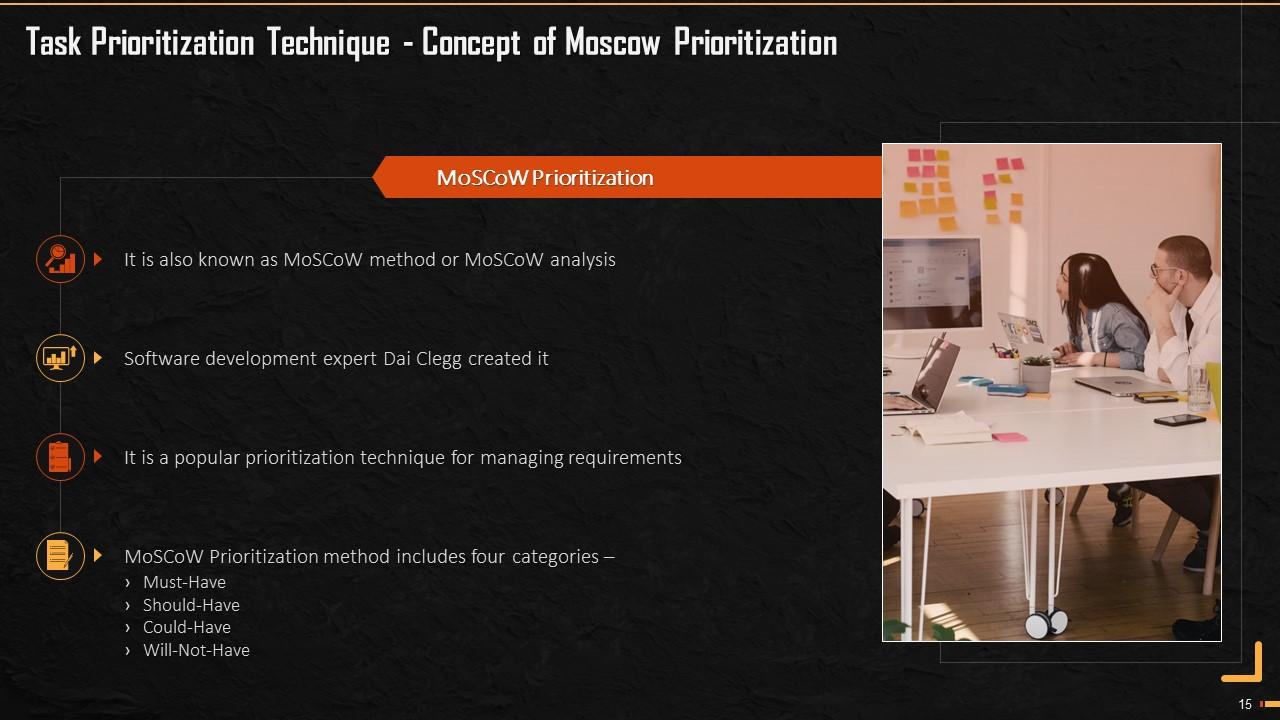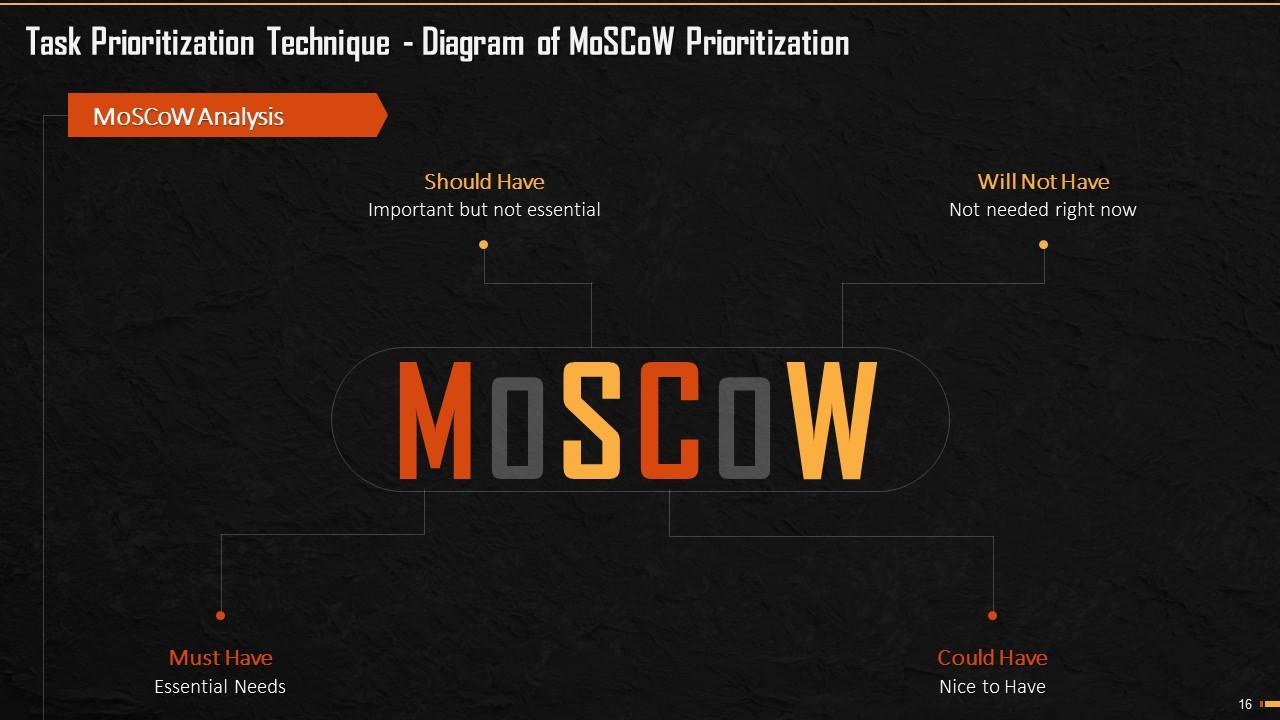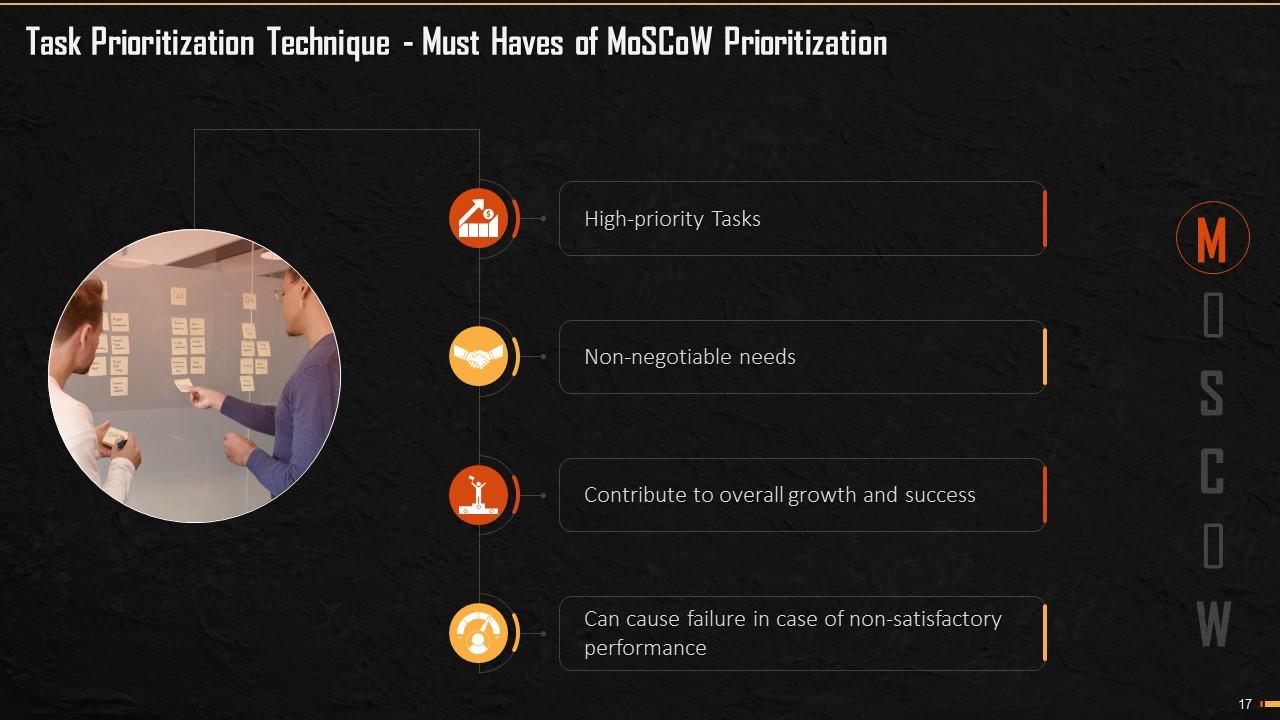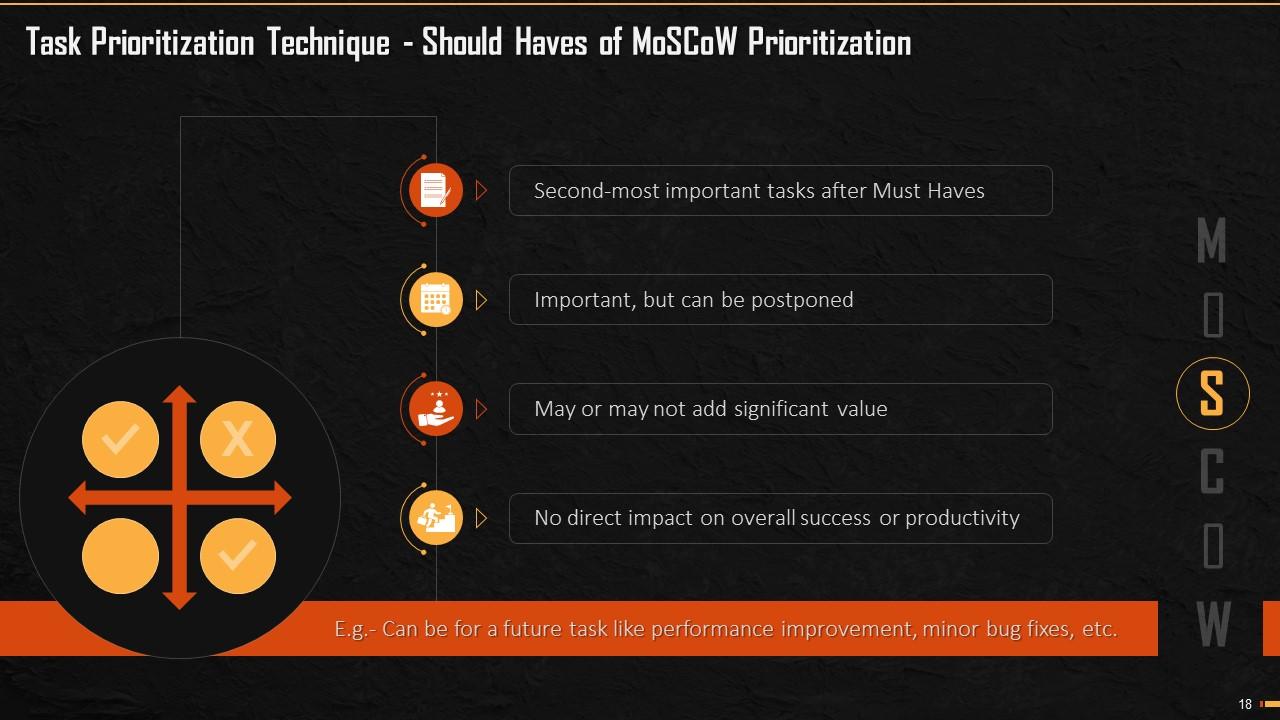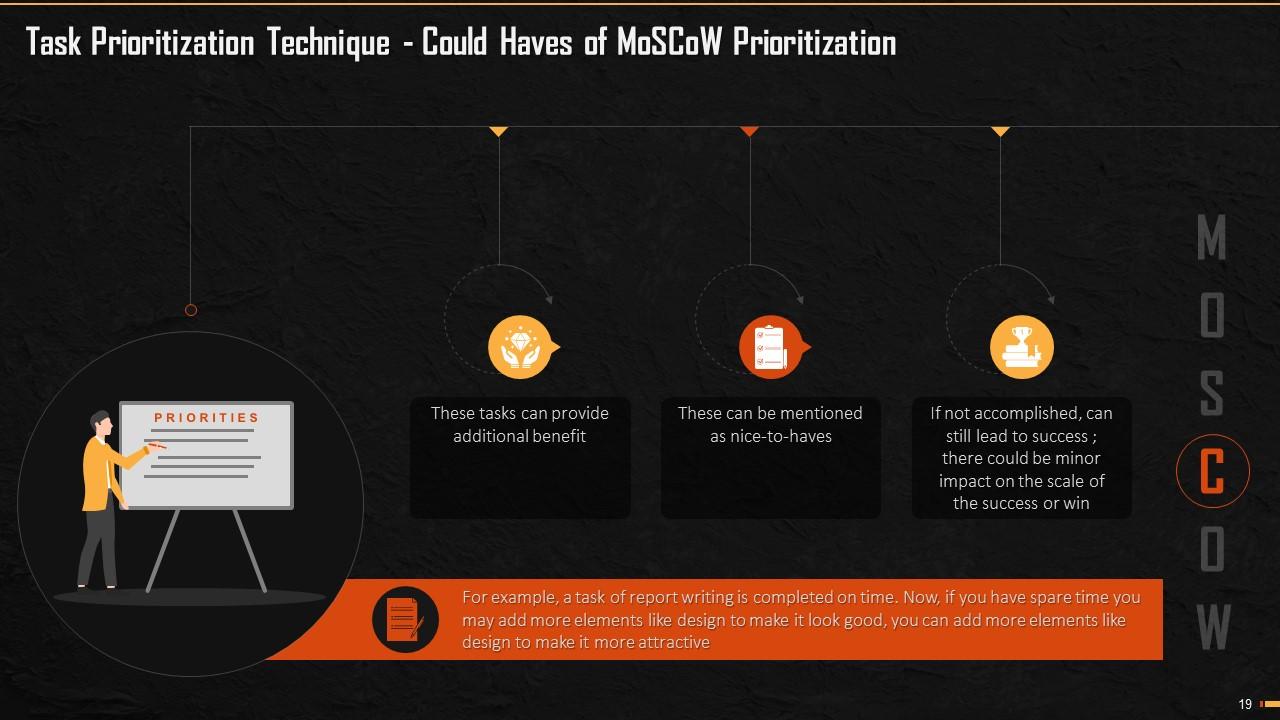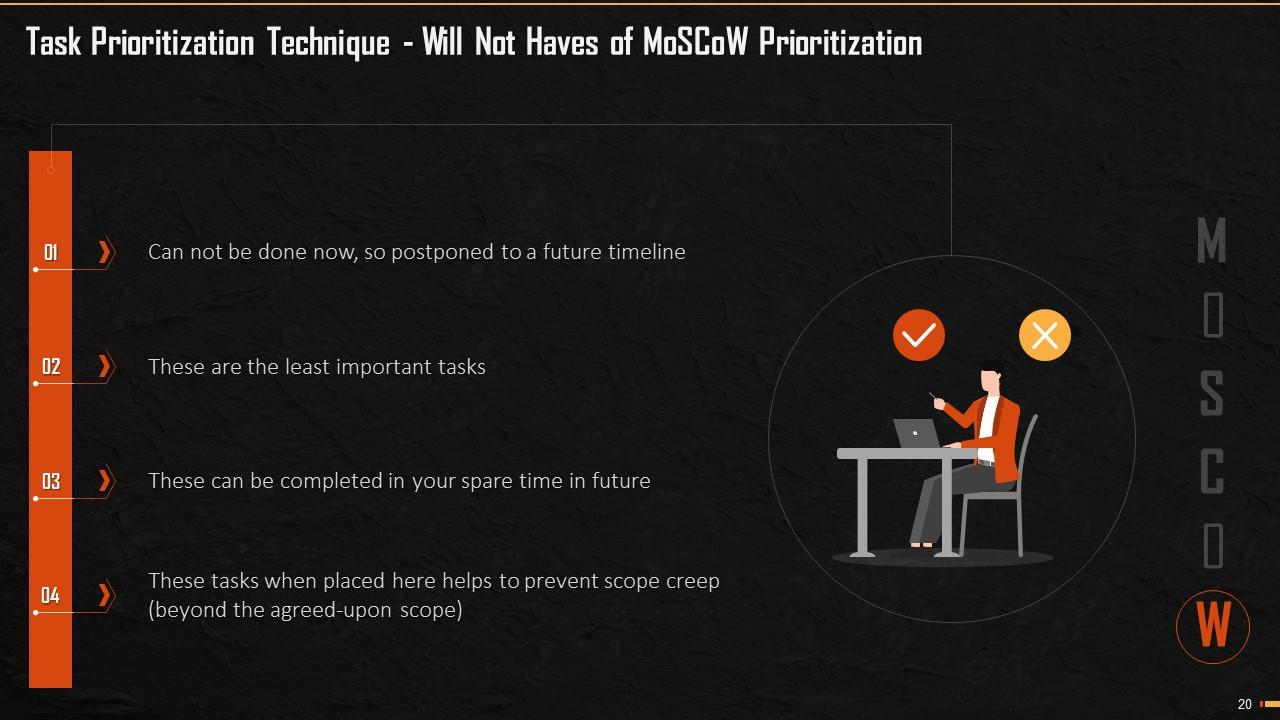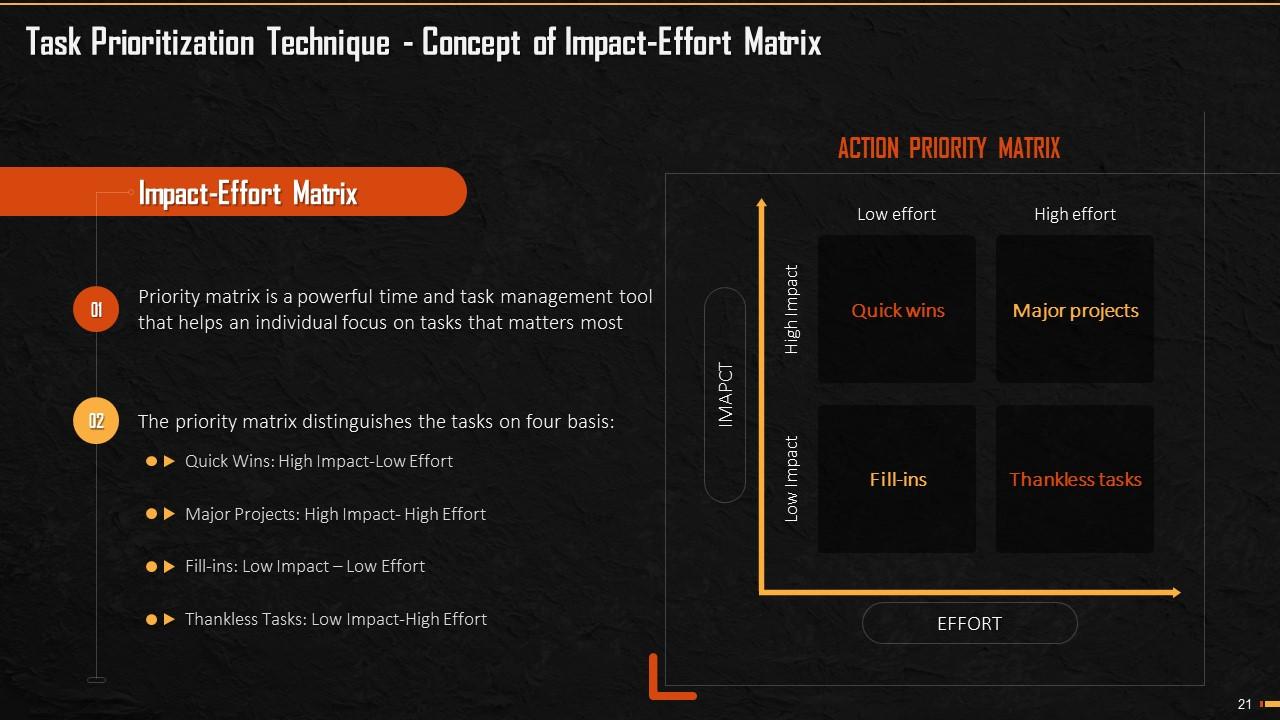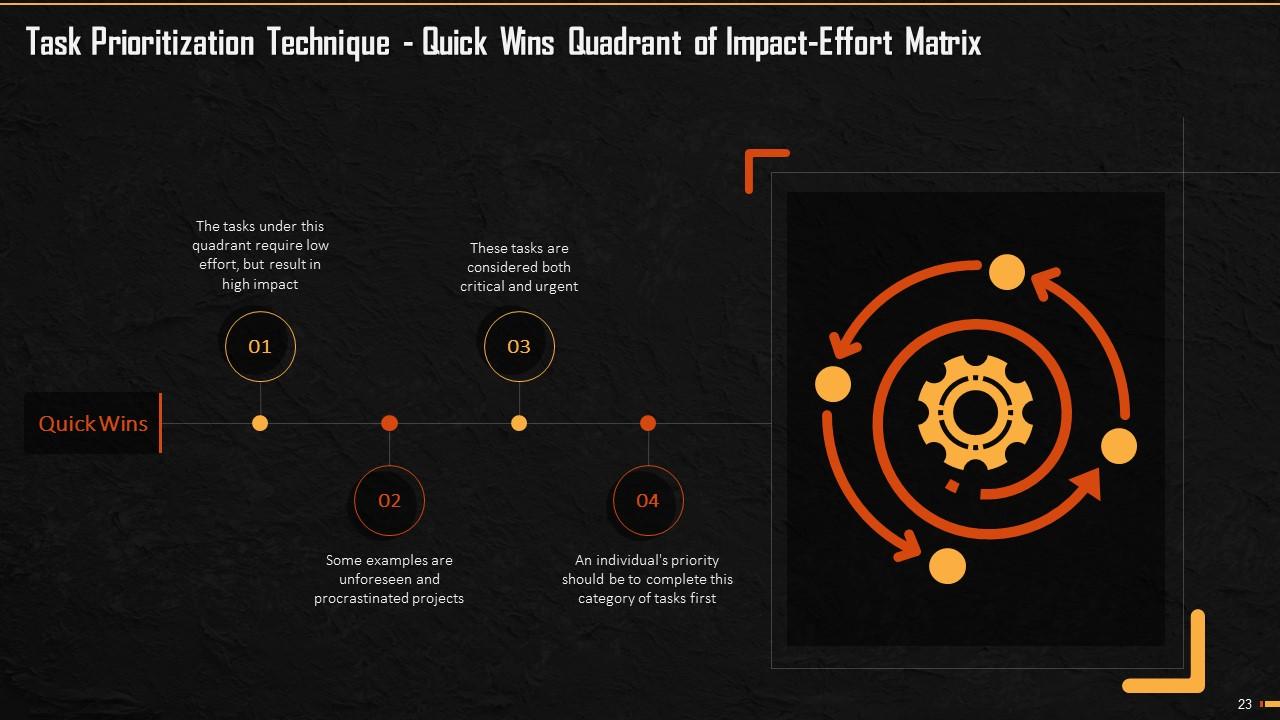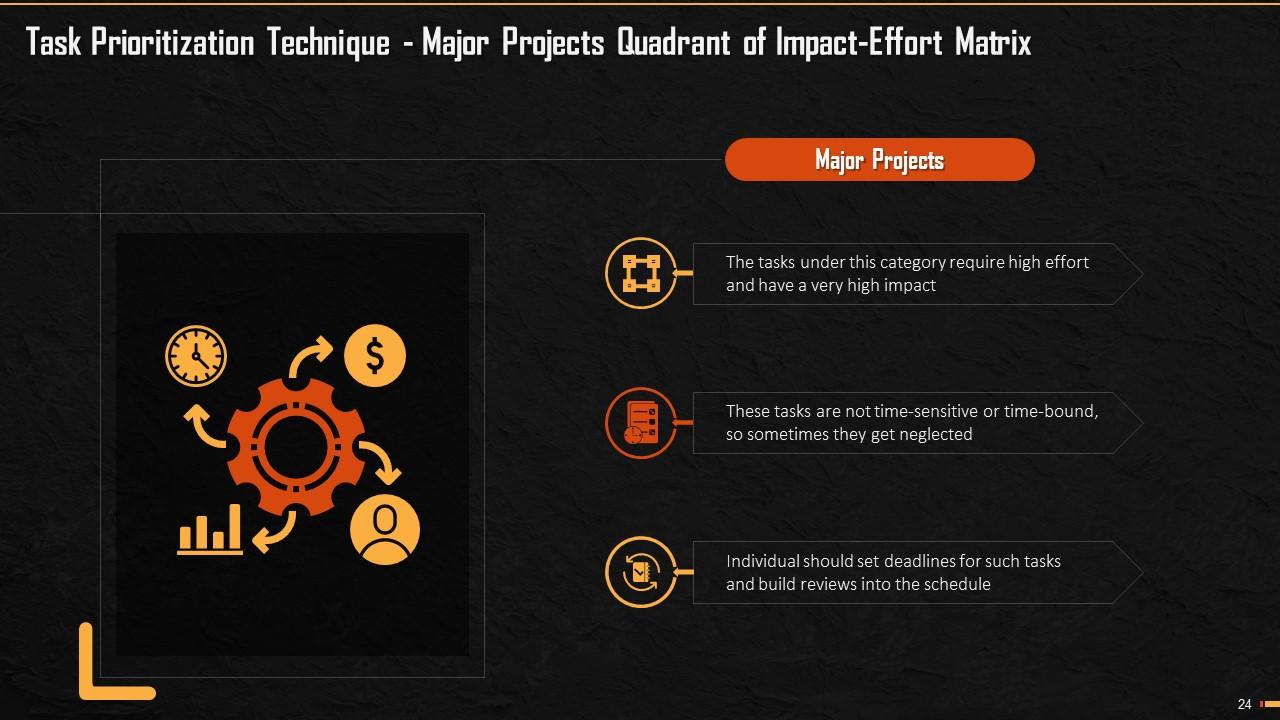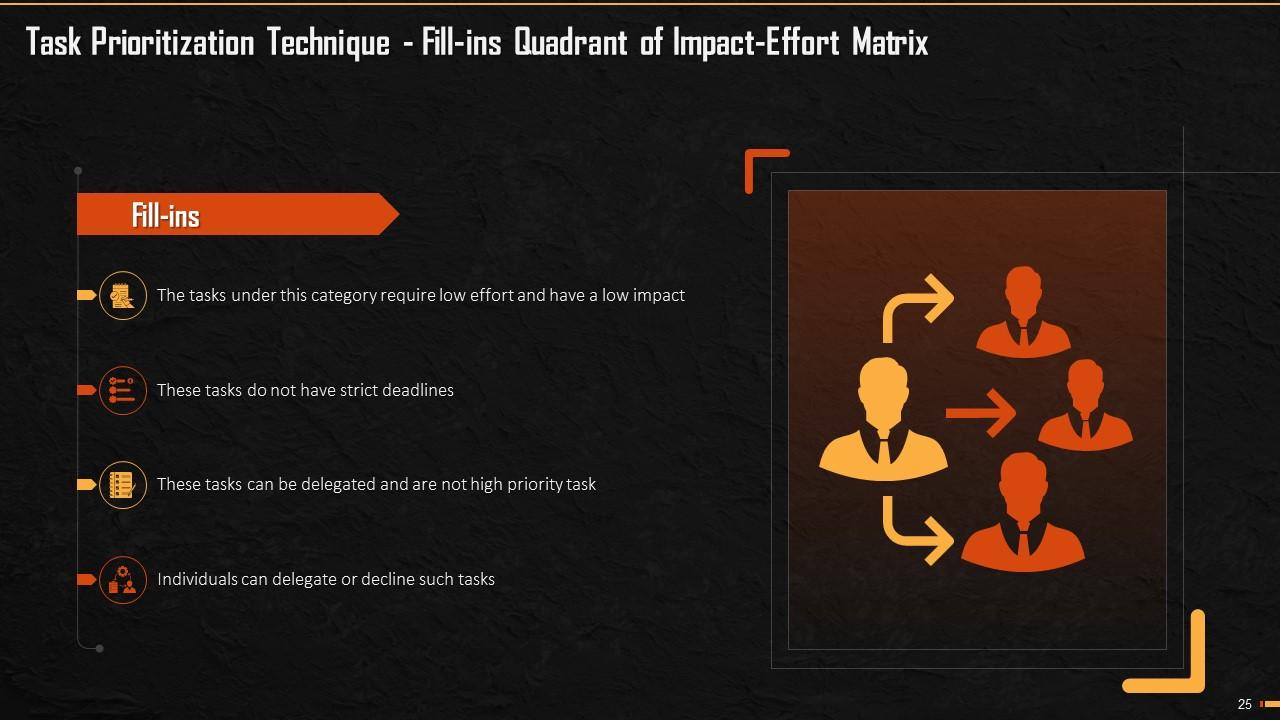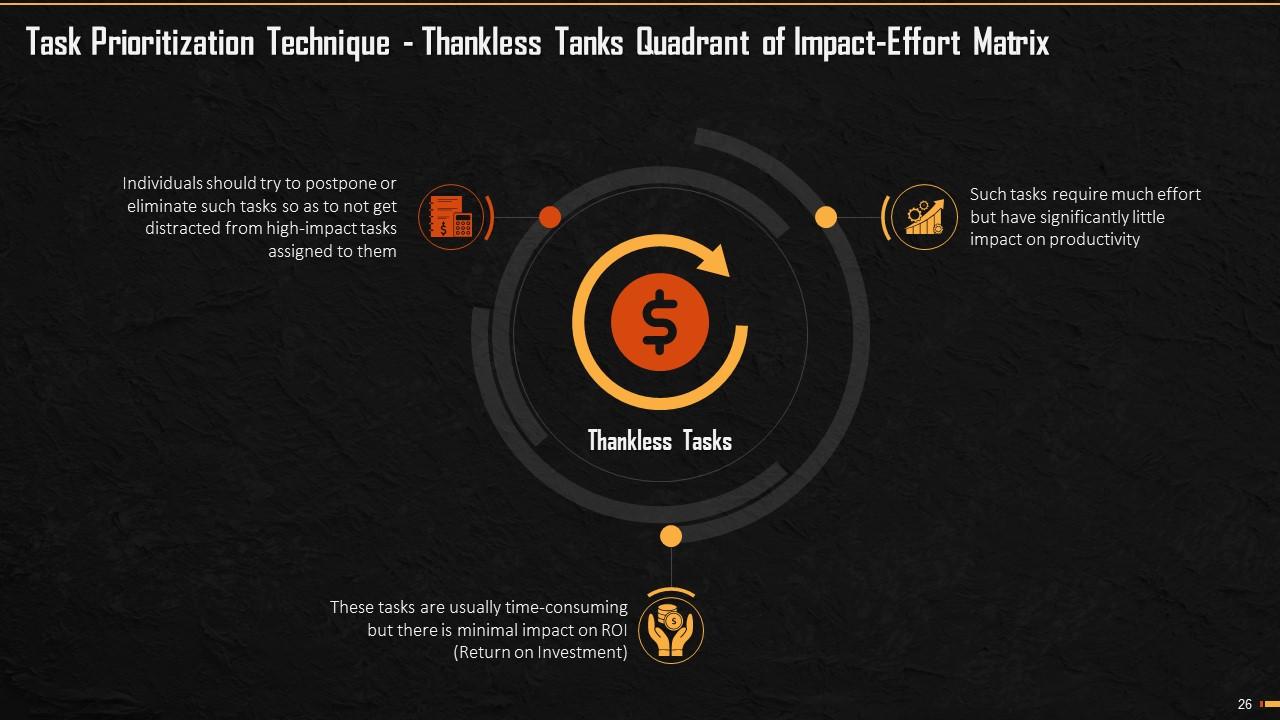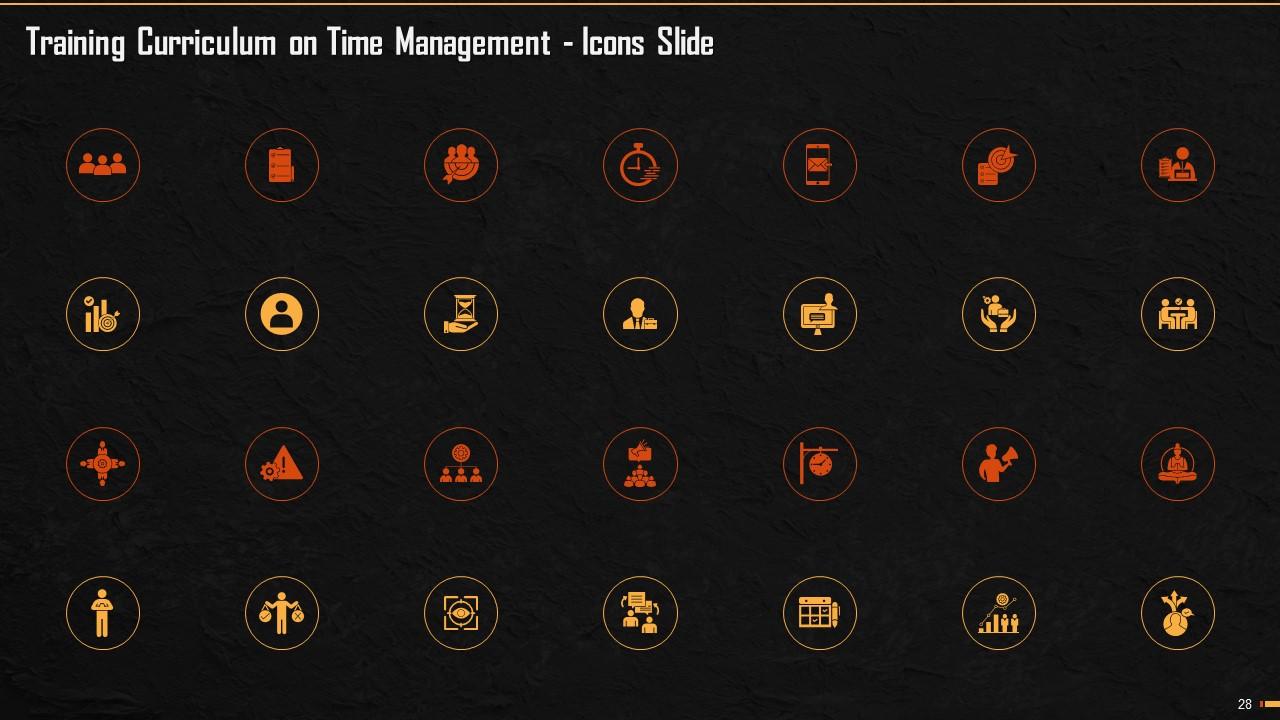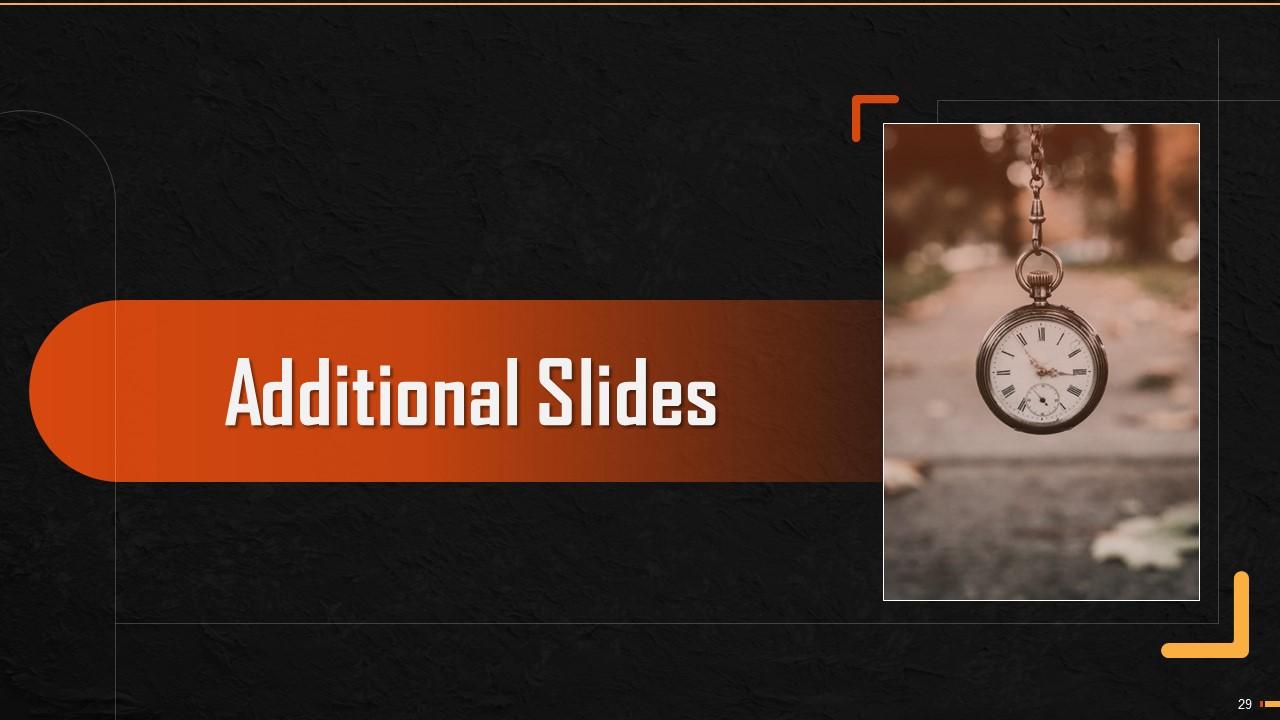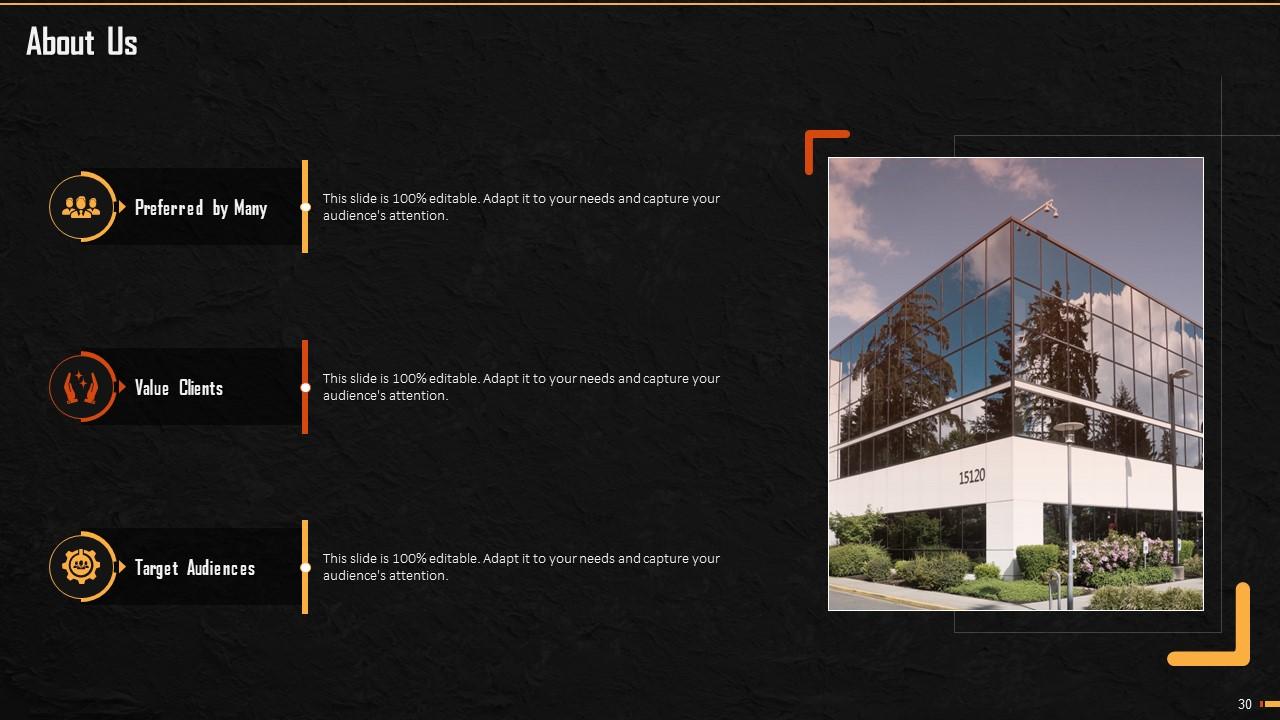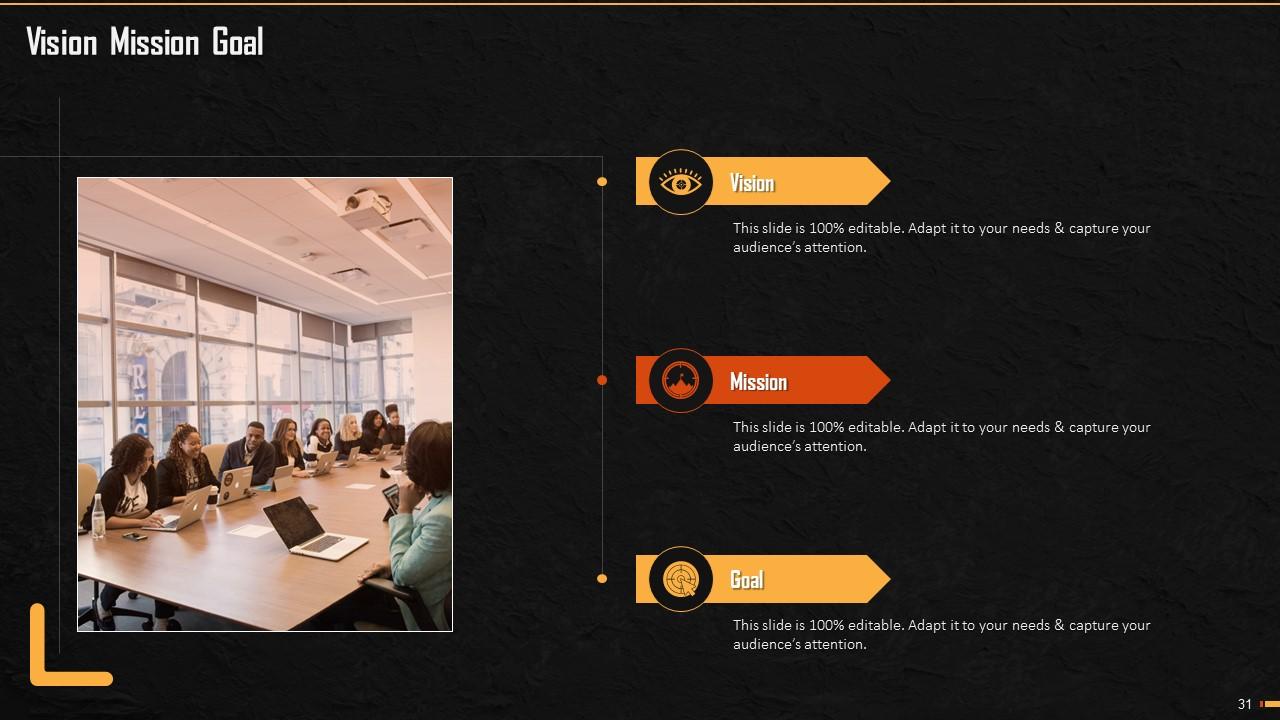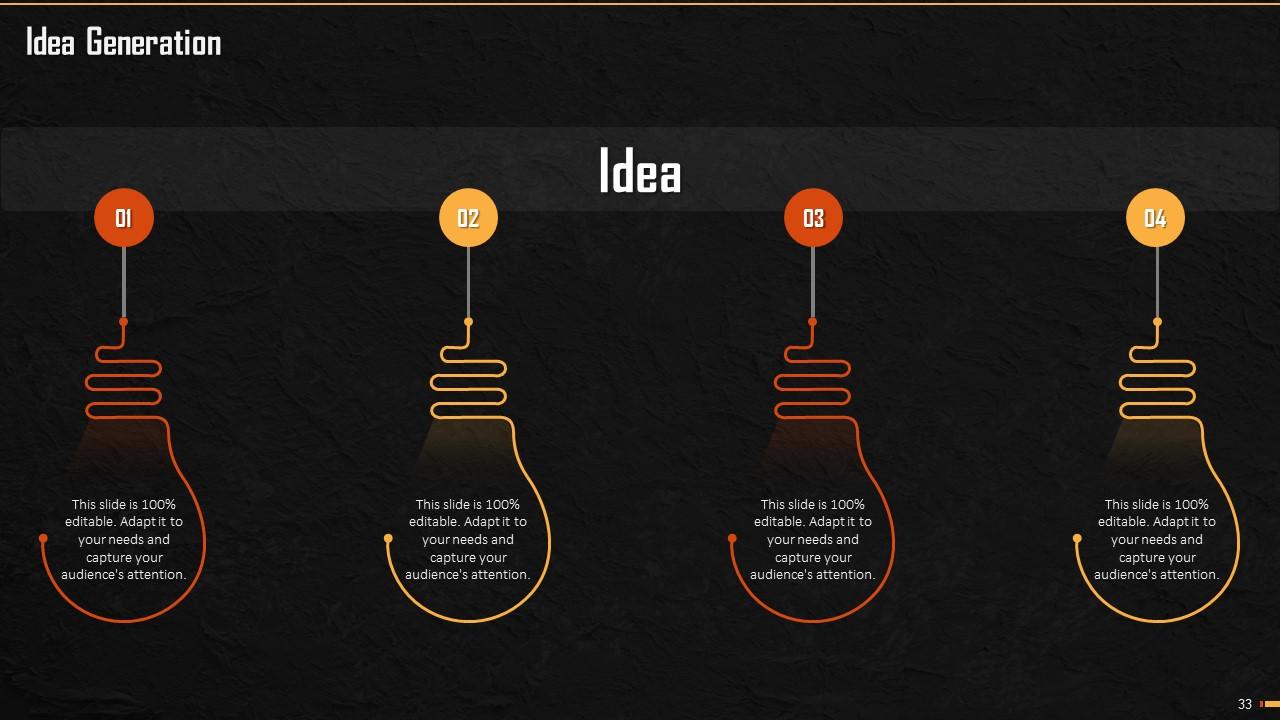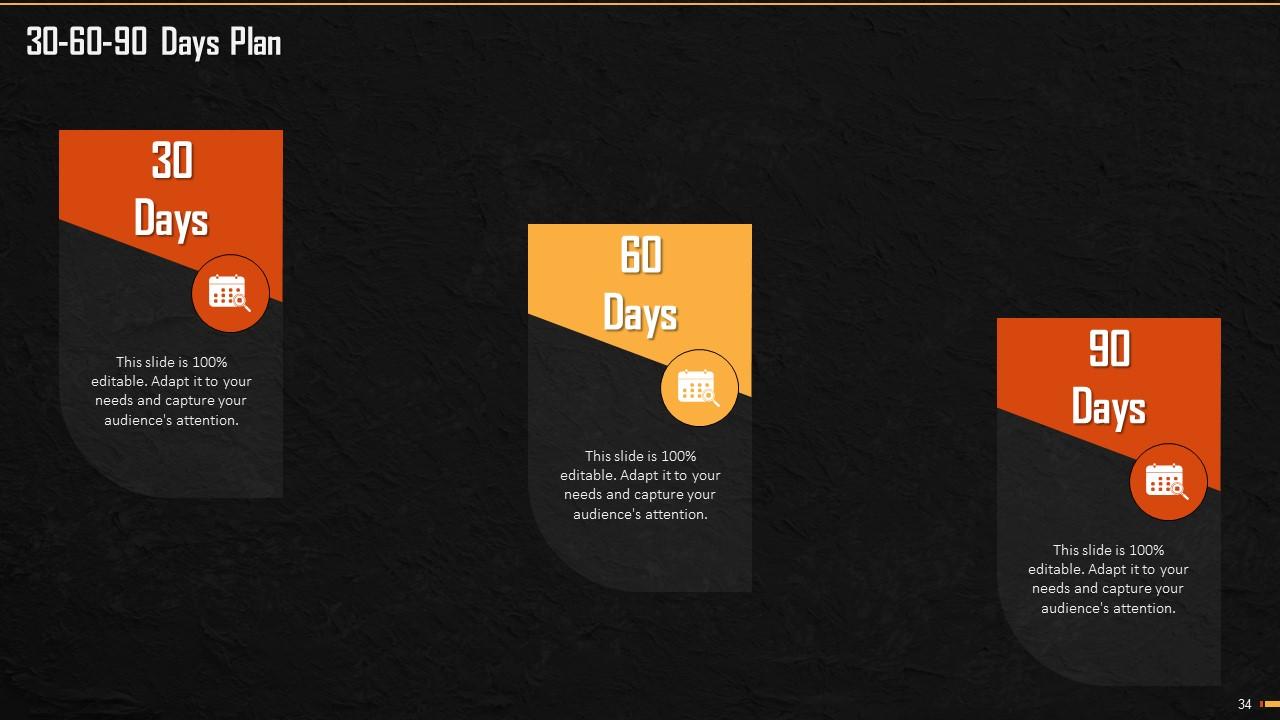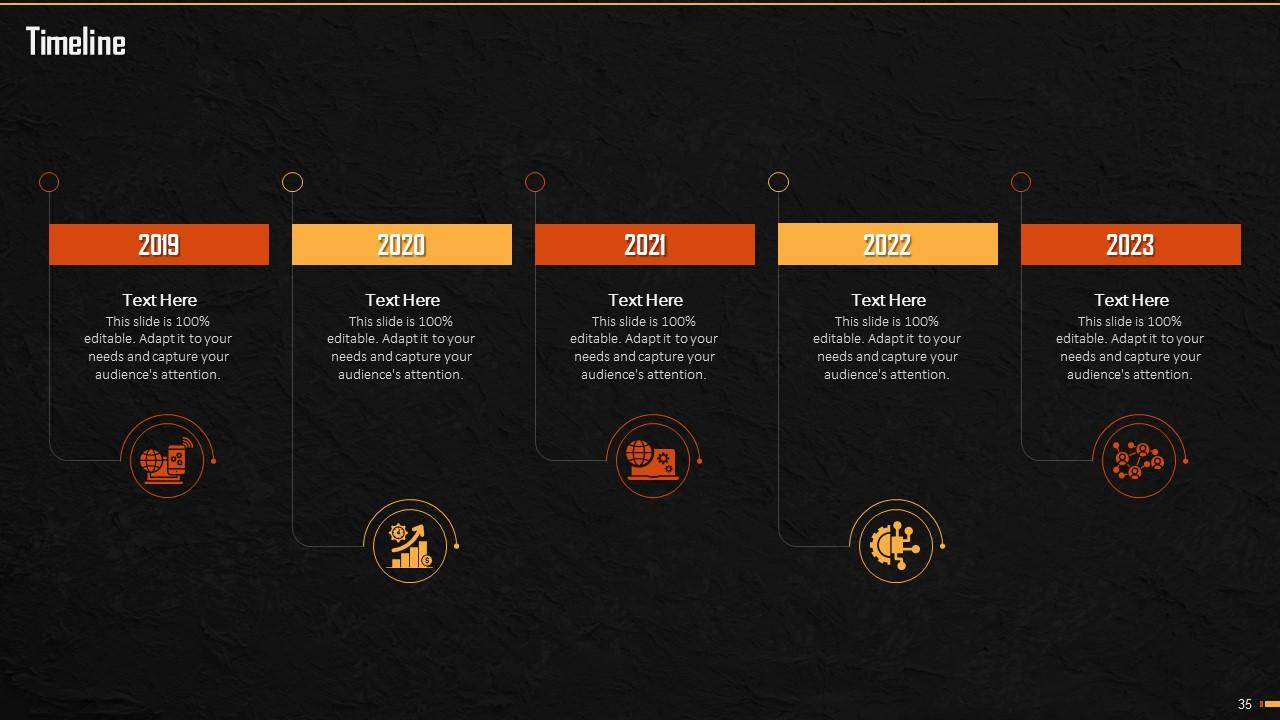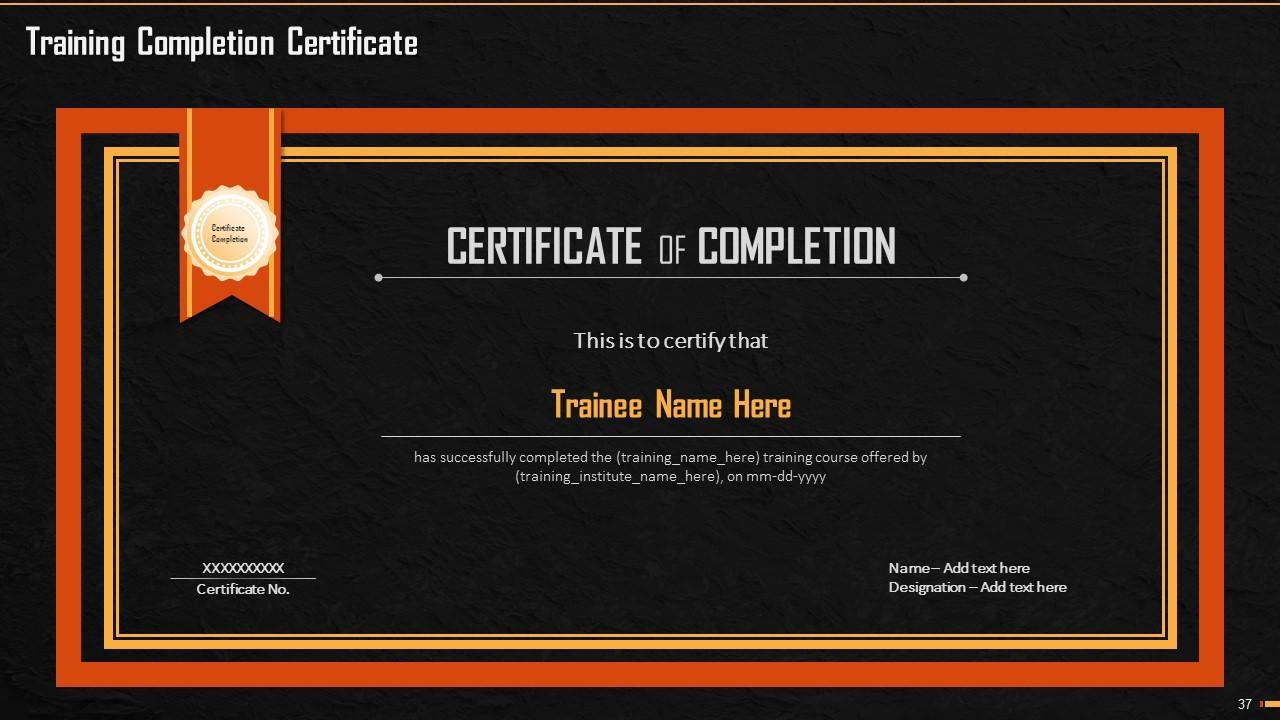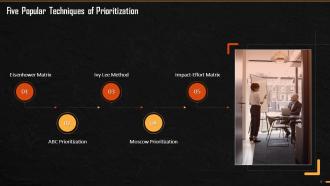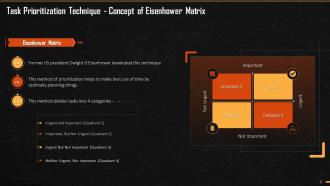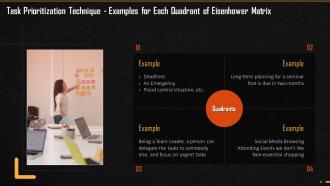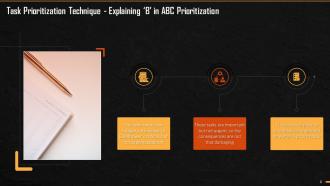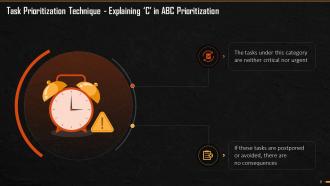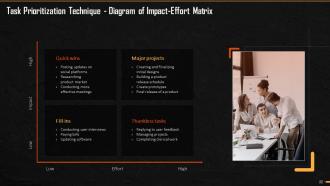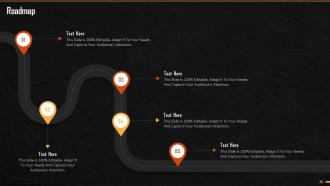Techniques To Master Prioritization At Workplace Training Ppt
This PPT deck in detail covers the task prioritization techniques, which are Eisenhower Matrix, ABC Prioritization, Ivy Lee Method, MoSCow Prioritization, and Impact-Effort Matrix. These showcase how to apply these methods at the workplace for better productivity and efficiency.
This PPT deck in detail covers the task prioritization techniques, which are Eisenhower Matrix, ABC Prioritization, Ivy Lee..
- Google Slides is a new FREE Presentation software from Google.
- All our content is 100% compatible with Google Slides.
- Just download our designs, and upload them to Google Slides and they will work automatically.
- Amaze your audience with SlideTeam and Google Slides.
-
Want Changes to This PPT Slide? Check out our Presentation Design Services
- WideScreen Aspect ratio is becoming a very popular format. When you download this product, the downloaded ZIP will contain this product in both standard and widescreen format.
-

- Some older products that we have may only be in standard format, but they can easily be converted to widescreen.
- To do this, please open the SlideTeam product in Powerpoint, and go to
- Design ( On the top bar) -> Page Setup -> and select "On-screen Show (16:9)” in the drop down for "Slides Sized for".
- The slide or theme will change to widescreen, and all graphics will adjust automatically. You can similarly convert our content to any other desired screen aspect ratio.
Compatible With Google Slides

Get This In WideScreen
You must be logged in to download this presentation.
PowerPoint presentation slides
Presenting Techniques to Master Prioritization at Workplace. These slides are 100 percent made in PowerPoint and are compatible with all screen types and monitors. They also support Google Slides. Premium Customer Support is available. Suitable for use by managers, employees, and organizations. These slides are easily customizable. You can edit the color, text, icon, and font size to suit your requirements.
People who downloaded this PowerPoint presentation also viewed the following :
Content of this Powerpoint Presentation
Slide 1
This slide lists techniques used in prioritizing tasks. These are Eisenhower Matrix, ABC Prioritization, Ivy Lee Method, MoSCowPrioritization,, and Impact-Effort Matrix.
Slide 2
This slide explains the Eisenhower Matrix of Prioritization. Ex-US President Dwight D. Eisenhower developed it. The technique helps to optimally manage time and plan things. This method divides tasks into four main quadrants – Urgent and Important; Important, but not Urgent; Urgent but not Important, and Neither Urgent Nor Important.
Slide 3
This slide mentions how Eisenhower matrix is prepared and what each quadrant means. This method divides the tasks into 4four main quadrants of Urgent and Important; Important, but not Urgent; Urgent, but not Important and Neither Urgent Nor Important.
Slide 4
This slide explains the examples for each quadrant of the Eisenhower matrix that is the tasks that are Urgent and Important; Important, but not Urgent; Urgent, but not Important and Neither Urgent Nor Important.
Slide 5
This slide explains the ABC Prioritization Technique of Prioritization. Alan Lakein developed it and the technique uses the first three letters of the alphabet to set the priorities.
Slide 6
This slide explains the ABC Prioritization Technique of Prioritization. It uses the three alphabets on the basis of urgency and importance.
Slide 7
This slide explains the A element of ABC Prioritization Technique. The tasks under this category go under the critical and urgent section of Eisenhower Matrix. These tasks should be done, and if not done, there are consequences to it. The example is not being able to finish a task that your senior needs by the next day.
Slide 8
This slide explains the B element of ABC Prioritization Technique. The tasks under this category are similar to Eisenhower’s ‘critical, but not urgent’ quadrant. These tasks are important but not urgent, so the consequences are not that severe.
Slide 9
This slide explains the C element of ABC Prioritization Technique. The tasks under this category are neither critical nor urgent. If these tasks are postponed or avoided, there are no consequences.
Slide 10
This slide summarizes the ABC Prioritization Technique. It says that an individual should start with the tasks ranked A1 and then move forward to other A category tasks followed by B and C category tasks. An Individual should make sure that they do not move to B and C category tasks unless they have completed the A priority tasks.
Slide 11
This slide mentions the activity that a trainer can conduct during a session. This exercise is based on the ABC technique of prioritization and will help the trainees plan their day better.
Slide 12
This slide explains the Ivy Lee Method and the steps followed in this method for prioritization of tasks. It says that this method was developed 100 years ago by productivity consultant ‘Ivy Lee’. This is one of the simplest methods to prioritize your tasks in the best possible manner.
Slide 13
This slide illustrates the Ivy Lee Method of Prioritization. In this slide, the diagram explains how priorities are listed and considered in this method.
Slide 14
This slide explains the steps followed in the Ivy Lee Method of Prioritization. There are five steps to be followed- At the end of the day, list down the six most important tasks (not more) to be accomplished the next day, Rank/Prioritize them on the basis of their actual importance. The next day, start with the most important task and do not move to the next task till this is done, Continue with other five tasks in the same way. If at the end of the day, there is any pending task, move it to the fresh list of six tasks for the following day. Repeat the process daily.
Slide 15
This slide explains the meaning and concept of MoSCoW method of Prioritization. It says Software development expert Dai Clegg created it. It is also known as MoSCoW method or MoSCoW analysis. It includes four main categories – Must Have, Should Have, Could Have, and Will Not Have.
Slide 16
This slide depicts the diagram for MoSCoW Method of Prioritization. It mentions the major elements of MoSCoW method and their meaning in prioritizing tasks.
Slide 17
This slide explains the first head of MoSCoW analysis that is ‘Must Have’. These are high priority tasks that contribute to the overall growth and success. These tasks when not performed to a high degree of satisfaction, can cause overall failure.
Slide 18
This slide explains the second head of MoSCoW analysis that is ‘Should Have’. These are the second priority tasks after the Must Haves. These tasks are important but can be postponed. These tasks do not add significant value to productivity and do not have direct impact on overall success.
Slide 19
This slide explains the third head of MoSCoW analysis that is ‘Could Haves’. These tasks provide additional or add-on benefit to the ongoing performance. These tasks, even if skipped, do not pose any hindrance to the achievement of successful results.
Slide 20
This slide explains the fourth head of MoSCoW analysis that is’ Will Not Haves’. These are tasks that cannot be immediately and are, usually, pushed to a future date. These are the least important tasks that need to be completed only if you get free time, after all the important and urgent tasks have been addressed.
Slide 21
This slide explains the meaning and concept of priority matrix. It is a powerful time and task management tool that helps an individual focus on tasks that matters the most and keeps the crucial tasks on track. As mentioned, it categorizes tasks on the basis of effort these require and the impact they will have on performance and productivity. There are four quadrants in priority matrix. The Quadrant 1 is Quick Wins, followed by three other quadrants that are Major Projects, Fill-Ins and Thankless Tasks, etc.
Slide 22
This slide explains the Priority Matrix, how is it built, and the quadrants in it.
Slide 23
This slide explains the first quadrant of priority matrix that is quick wins. It says that the tasks under this quadrant require low effort but have high impact. An individual's priority should be to complete this category of tasks first.
Slide 24
This slide explains the second quadrant of priority matrix that is major projects. It says that the tasks under this under this category require high effort and have a very high impact. Individual should set deadlines for such tasks and build checkpoints into the schedule.
Slide 25
This slide explains the third quadrant of priority matrix that is fill-ins. It says that the tasks under this under this category require low-effort and have low impact. Individuals can delegate or decline such tasks.
Slide 26
This slide explains the fourth quadrant of priority matrix that is thankless tasks. It says that the tasks in this quadrant require a lot of effort, but have little impact on productivity. Individual should try to postpone or eliminate such tasks so as to not get distracted from high-impact tasks.
Techniques To Master Prioritization At Workplace Training Ppt with all 42 slides:
Use our Techniques To Master Prioritization At Workplace Training Ppt to effectively help you save your valuable time. They are readymade to fit into any presentation structure.
-
Such amazing slides with easy editable options. A perfect time-saver.
-
The Designed Graphic are very professional and classic.




